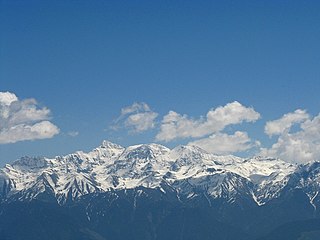
The Pir Panjal Range is a chain of mountains in the Lower Himalayan region located in the Western Himalayas of northern Indian subcontinent. It runs southeast to northwest between the Beas and Neelam/Kishanganga rivers, in the Indian territory of Himachal Pradesh and disputed Jammu and Kashmir, with its northwestern end extending into Pakistan. The Himalayas show a gradual elevation towards the Dhauladhar and Pir Panjal ranges. Pir Panjal is the largest range of the Lesser Himalayas. Near the bank of the Sutlej River, it dissociates itself from the Himalayas and forms a divide between the Beas and Ravi rivers on one side and the Chenab on the other. Further west, the Pir Panjal range separates the Kashmir Valley from the hills of Jammu region.

The Jammu–Baramulla line is a railway track being laid to connect the Kashmir Valley in the Indian union territory of Jammu and Kashmir with Jammu railway station and thence to the rest of the country. The 338 km railway track will start from Jammu and end at Baramulla. It comes under the jurisdiction of the Firozpur railway division of Indian Railways' Northern zone. Part of this railway route from Udhampur to Baramulla is known as Udhampur-Srinagar-Baramula Rail Link (USBRL). The 359 m (1,178 ft) tall Chenab Bridge lies on this line, which is the tallest railway bridge in the world. The total project cost in 2022 was INR28,000 crore.

The Hokersar is a wetland conservation area in Zainakote, near Srinagar city in Srinagar district of Jammu and Kashmir, India. It lies in the Kashmir Valley, 10 kilometres (6.2 mi) northwest of Srinagar. The Hokersar, which spreads over 1,375 hectares (13.75 km2), is a designated bird sanctuary.

Shopian or Shupiyan ,, known as Shupyan in Kashmiri, is an administrative division of the Shopian district, located in southern part of Kashmir Valley, of Jammu and Kashmir, India. Shopian is called the ''Apple town of Kashmir'' as majority of the population engages in apple growing practices which also provides employment to more than 60% of the population. It is 2nd richest district in Kashmir region after Srinagar.
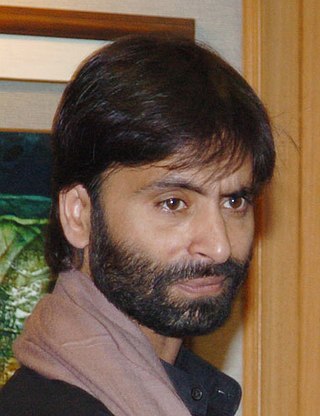
Yasin Malik is a Kashmiri separatist leader and former militant who advocates the separation of Kashmir from both India and Pakistan. He is the Chairman of the Jammu Kashmir Liberation Front, which originally spearheaded armed militancy in the Kashmir Valley. Malik renounced violence in 1994 and adopted peaceful methods to come to a settlement of the Kashmir conflict. In May 2022, Malik pleaded guilty to charges of criminal conspiracy and waging war against the state, and was sentenced to life imprisonment.

Maqbool Bhat also spelt Maqbool Butt was a Kashmiri separatist leader who fled to Pakistan and founded the militant group National Liberation Front (NLF), which was a precursor to the present day Jammu Kashmir Liberation Front (JKLF). Bhat carried out multiple attacks in Jammu and Kashmir (state). He was captured and sentenced to double death sentence. He was hanged on 11 February 1984 in Tihar Jail in Delhi.

Baba Ghulam Shah Badshah University is a State university in India which came into existence by the Act of the Jammu and Kashmir Legislative Assembly in 2002. The university is named after saint Baba Ghulam Shah Badshah. The university campus is located at the foothills of the great Himalayan Pir Panjal range in Rajouri, 154 km (96 mi) from Jammu, the Winter capital & 180 km (110 mi) from Srinagar, the Summer capital of Jammu and Kashmir union territory. It focuses on undergraduate engineering courses, a diverse postgraduate courses and research in fields such as management, environment, biodiversity, bio-technology, computer sciences, information technology, and applied mathematics. Akbar Masood was appointed as Vice Chancellor on 13 February 2021.
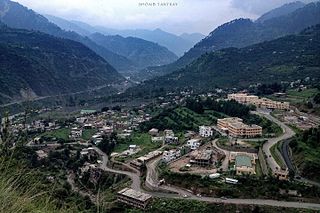
Ramban district is an administrative district in the Jammu division of Indian-administered Jammu and Kashmir in the disputed Kashmir region. It is located in a valley surrounded the Pir Panjal range. It was carved out as a separate district from erstwhile Doda district in 2007. It is located in the Jammu division. The district headquarters are at Ramban town, which is located midway between Jammu and Srinagar along the Chenab river in the Chenab valley on National Highway-44, approximately 151 km from Jammu and Srinagar.

Mughal Road is the road between Bufliaz, a town in the Poonch district, to the Shopian district, in the union territory of Jammu and Kashmir, India. The 84-kilometre road traces a historic route used in the Mughal period over the Pir Panjal Pass, at an altitude of 3,500 m (11,500 ft), higher than the Banihal pass at 2,832 m (9,291 ft).

Tosa Maidan is a tourist destination and a hill station in the khag area of the Budgam district in the Kashmir Valley of the Indian union territory of Jammu and Kashmir. The name also marks the historic Tosa Maidan route into the Kashmir Valley from the Poonch Valley. In fact, the original name of Tosa Maidan appears to have been "Tosa Marg". Mahmud of Ghazni and the Sikh monarch Ranjit Singh attempted to invade the Kashmir Valley via this route.
Masarat Alam Bhat is a Kashmiri Islamist activist and Political separatist leader of Jammu and Kashmir. He is currently serving as the chairman of the Jammu Kashmir Muslim League, and also serves as the interim chairman of Geelani faction of the All Parties Hurriyat Conference.

Kashmiri cinema is the Kashmiri language-based film industry in the Kashmir Valley of the India administered union territory of Jammu and Kashmir. The first Kashmiri feature film, Mainz Raat, was released in 1964. In 2023, Welcome to Kashmir directed by Tariq Bhat became the first-ever Kashmiri produced Bollywood film to release in Kashmiri cinemas.

Ghulam Nabi Lone (Hanjura) is an Indian politician and former cabinet minister of Jammu and Kashmir, belonging to the Jammu and Kashmir Peoples Democratic Party. An Advocate by profession, Lone was part of the 12th Jammu and Kashmir Legislative Assembly from Charari Sharief constituency.
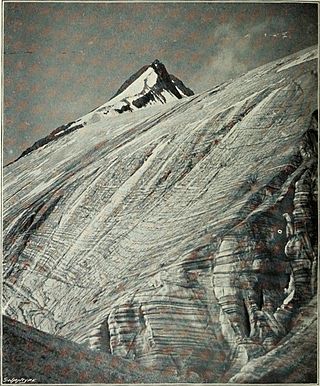
The Panjal Traps or the Tethyan Plume is a large igneous province (LIP) that erupted during the Early–Middle Permian in what is now north-western India. The Panjal Traps are associated with the opening of the Neo-Tethys Ocean, which resulted in the dispersal of the Cimmerian continental blocks from the north-eastern margin of Gondwana and possibly the break-up of this old and large continent. In the Zanskar-Spliti-Lahaul area the 30–150 m (98–492 ft)-thick basalts of the Panjal Traps are mostly exposed as massive (terrestrial) lava flows, but also as (marine) pillow lavas and hyaloclastites.
Elections for the Indian state of Jammu and Kashmir were held in February 1967. Ghulam Mohammed Sadiq was appointed Chief Minister of Jammu and Kashmir.
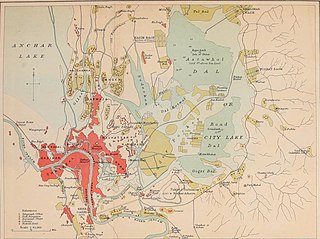
New Theed is a notified area in Srinagar city known for its historical significance and natural surroundings.

Jammu and Kashmir is a region administered by India as a union territory and consists of the southern portion of the larger Kashmir region, which has been the subject of a dispute between India and Pakistan since 1947 and between India and China since 1959. The Line of Control separates Jammu and Kashmir from the Pakistani-administered territories of Azad Kashmir and Gilgit-Baltistan in the west and north. It lies to the north of the Indian states of Himachal Pradesh and Punjab and to the west of Ladakh which is administered by India as a union territory.

The Pir Panjal Region is a region located in the southwestern part of the Pir Panjal Range in the Jammu Division of the Indian-administered union territory of Jammu and Kashmir. This name particularly refers to the districts of Poonch and Rajouri.
Education in Jammu and Kashmir is based on 5-tier model which includes primary schools, middle schools, higher secondary schools, Colleges and University. As per the census of 2011, Jammu and Kashmir has the literacy rate of 68%. However, there has been an increase in the numbers in recent years.















